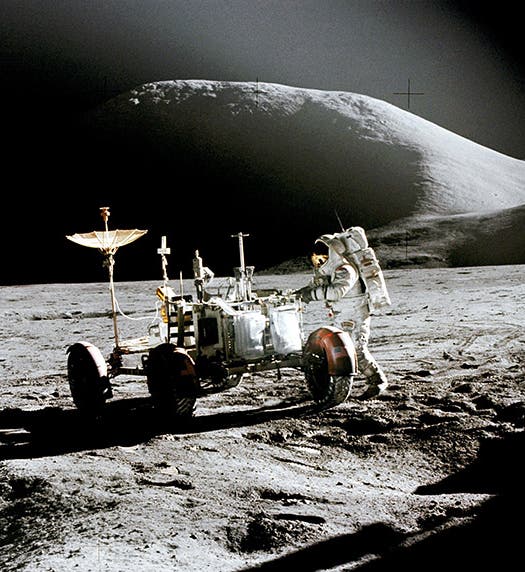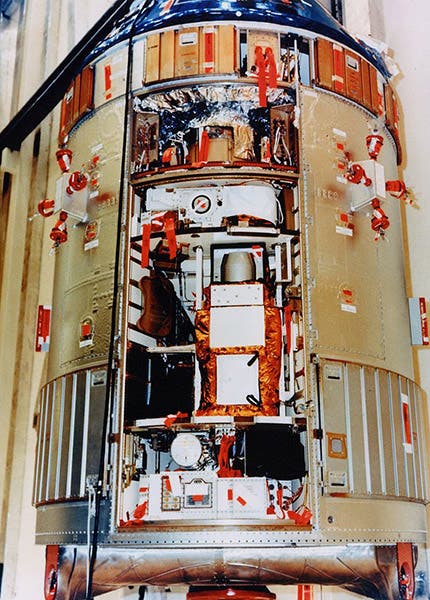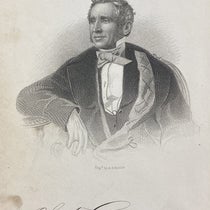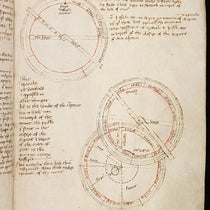Scientist of the Day - Apollo 15
Falcon, the lunar module of Apollo 15, a NASA mission, touched down on the lunar surface on July 30, 1971. This was the fourth Apollo spacecraft to land on the Moon, and the first of a new breed of LEM, larger, heavier, and carrying a car in its trunk, which once unpacked and unfolded, brought a new dimension to lunar exploration. NASA persists in calling this a Lunar Roving Vehicle; to everyone else, it is a Lunar Rover (first image).
The crew of Apollo 15 included David Scott, the Commander; Alfred Worden, the Command Module Pilot (who did not get to walk on the moon), and James Irwin, the LEM pilot.
Apollo 11, 12, and 14 had all landed in relatively flat (and bland) areas of the Moon, a reasonable precaution for those first missions. Apollo 15 was the first to venture into the mountains, the lunar Apennines, to be specific. It landed near Crater Hadley C, in a plain called Hadley delta, right next to a picturesque gulley called Hadley Rille, which they would explore in the Rover. Apollo 15 had a more scientific emphasis than the earlier missions, with the astronauts crammed full of newly acquired geological knowledge and ready to find specimens that would shed light on the early history of the Moon. And they now had the payload capacity to haul hundreds of pounds of rocks back to the Falcon and thence to the Endeavour and home to the lunar lab in Houston. When Irwin and Scott spotted what they thought was an especially ancient chunk of anorthosite, they got very excited and immediately hailed it as the Genesis Rock, probably 4.5 billion years old. It turned to be more like a Deuteronomy rock, old but not primordial, but it is still a famous chunk of the lunar past (fourth image).
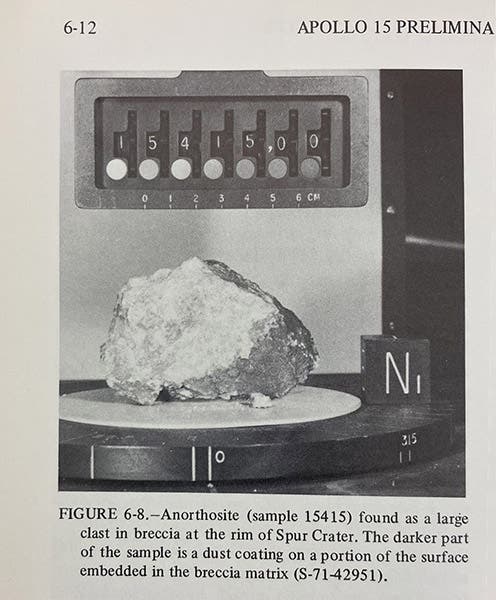
The Genesis Rock, a chunk of anorthosite, thought at the time to be primordial, retrieved from the lunar surface by James Irwin and David Scott, photographed in the Lunar Lab in Houston, Apollo 15: Preliminary Science Report, NASA Special Publications (SP-289), 1972 (Linda Hall Library, Documents Collection)
All in all, Apollo 15 was a very successful mission. Irwin and Scott spent some 19 hours on the lunar surface, set up all sorts of experiments, and drove 17 miles in the Rover. Worden had a whole bay of equipment, the “SIM” bay (fifth image) on the Endeavour that he used to gather data and record images during the three days he was in orbit alone. He even made the first "deep space" tethered walk on the return trip to retrieve film capsules from the SIM bay. They splashed down near Hawaii on Aug. 7, 12 days after launch.
Only one thing marred the mission, and that was a bit of unscheduled and unauthorized activity by the crew, whereby they secreted a stack of first-day covers in their personal belongings on behalf of a German stamp dealer and hauled them all the way to the lunar surface, in exchange for payments to establish college funds for their kids. When it came out, Deke Slayton, head of Apollo crew deployment, was not at all pleased, and the Apollo 15 crew was taken off the ready list for any remaining missions. The dealer relinquished the stamps, the crew returned their payments, and so the future of western civilization looked bright again. Whew, that was close.
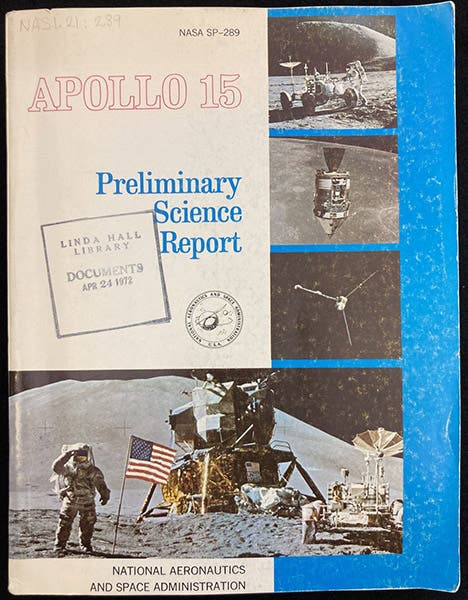
Front cover, Apollo 15: Preliminary Science Report, NASA Special Publications (SP-289), 1972 (Linda Hall Library, Documents Collection)
The Falcon is still on the Moon, with its Rover, but part of the Endeavour, the reentry capsule, made it back to Earth with the crew and is on display at the Air Force Museum at Wright-Patterson Air Force Base in Dayton, Ohio (third image).
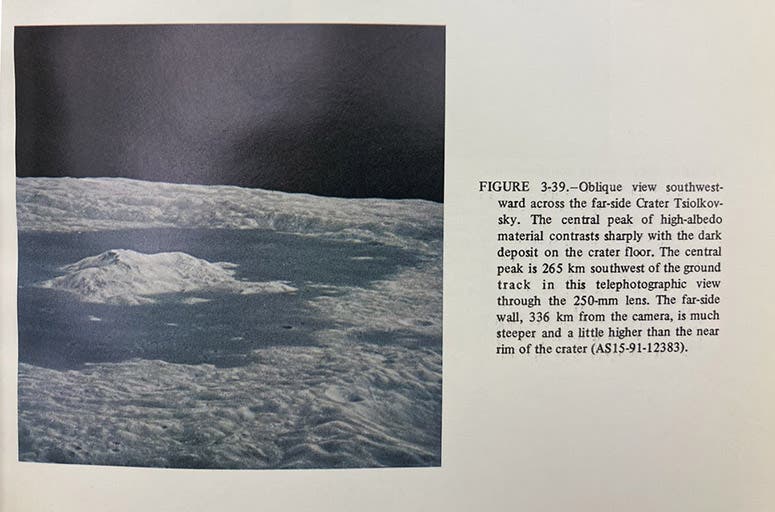
Photograph taken by the crew of Apollo 15 of the lunar crater Tsiolkovsky, on the far side of the Moon; it is the most magnificent crater on the Moon, and only 24 people have seen it in person. A color print was included in Apollo 15: Preliminary Science Report, NASA Special Publications (SP-289), p. 3-25, 1972 (Linda Hall Library, Documents Collection)
Since our library is a government documents depository, we have a slew of NASA documents related to the Apollo missions, and I pulled one from the shelf, a NASA Special Publication called Apollo 15: Preliminary Science Report, issued in 1972, which has lots of technical information of interest to only a few, but also some fine photos for the rest of us. Our photo of the Genesis Rock came from this publication, and the cover shows one of the most famous Apollo 15 photos, with Irwin saluting the American flag next to the perched Falcon during their first walk on the moon. Almost casually inserted into the book is a small color photo taken from orbit of the crater Tsiolkovsky on the far side of the Moon, in my opinion the most magnificent luna crater of them all, one that has been seen directly by only 24 humans, the 8 teams of Apollo astronauts who have seen the Moon from orbit (not counting the crew of Apollo 13, who had been busy trying to save their lives).
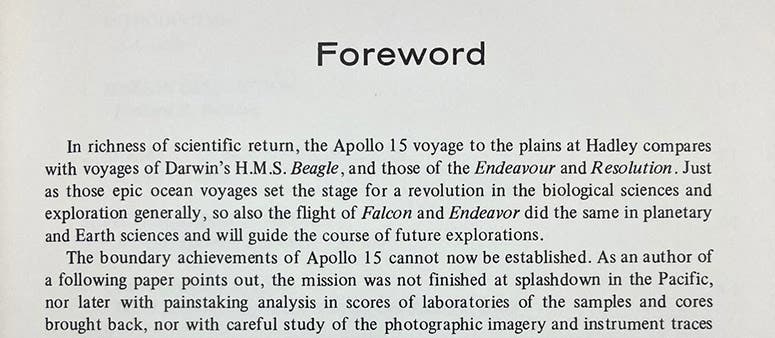
Beginning of the Foreword, written by NASA Administrator James C. Fletcher, comparing the flight of Apollo 15 to the voyages of Charles Darwin on the Beagle and Captain James Cook in the Endeavour, Apollo 15: Preliminary Science Report, NASA Special Publications (SP-289), 1972 (Linda Hall Library, Documents Collection)
I have always been amused by the foreword to the Preliminary Science Report, where NASA Administrator James Fletcher compares the flight of Apollo 15 to the voyages of Chales Darwin on the Beagle and James Cook on the Endeavour (last image). Hyperbole just never gets old.
Finally, if you are interested in seeing where Apollo 15 landed, in relation to the other Apollo landing sites, here is a very clever NASA video that reveals their locations one by one, time-lapse video style (click the Play arrow at lower left).
William B. Ashworth, Jr., Consultant for the History of Science, Linda Hall Library and Associate Professor emeritus, Department of History, University of Missouri-Kansas City. Comments or corrections are welcome; please direct to ashworthw@umkc.edu.

